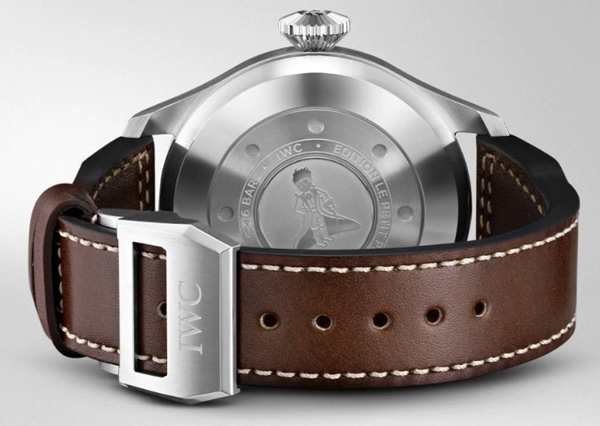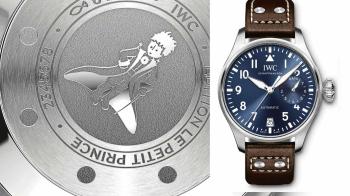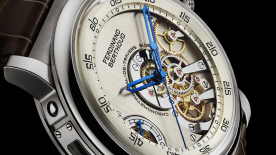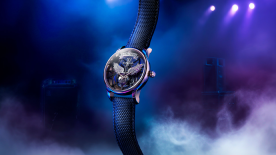I could have begun this article with the statement “Size doesn’t matter,” but as far as watches are concerned, this claim deserves some qualification. Size is one element that often determines the choice of a watch. A watch’s dimensions (diameter and thickness) are dictated by a number of elements: function, construction, gender and finally fashion.
The first criterion is the most obvious. Function determines the size, given that the case has to be able to contain a movement, which partially dictates the diameter of the timepiece. Nevertheless, other technical or ergonomic demands can also impose certain choices.
These can include, for example, the need for legibility on the Panerai watches of the 1940s. There are also technical considerations linked to the need to protect the watch. Soft iron is sometimes included to protect against magnetism (IWC), and other layers are added for water resistance. Finally, a sports watch will generally come in a bigger size than a dress watch.
The components used also play an important role. There’s the case, crown, crystal, caseback, dial, chapter ring and lugs. And that means that there is more than just the diameter to think about when choosing a watch. A large case with a small dial and wide chapter ring can help to “shrink” the perceived size (take a look at the Doxa Sub 300 reissue, which has a diameter of 42.5 mm, but a small dial).
A more modest case size paired with a generous dial and a slim chapter ring will have the opposite effect. Lugs also play a role: some are shorter, thus reducing the length of the watch, while others are longer and more slender. This affects the way the watch sits on the wrist.
Gender continues to be important: there are watches for women, and watches for men. For a long time, small watches were associated with feminine wrists, while a large timepiece was considered more masculine. Nevertheless, changing times and fashions have largely overturned this assumption. First, we saw women wearing 44 mm Panerais. Then there was the return to favour of vintage watches, which have an average size well below current norms (between 33 mm and 38 mm at most). It’s no longer surprising to see a man wearing a 35 mm gold Longines, and then lending it to his girlfriend! The differentiating factor is no longer gender but simply wrist size.
Some brands have even fallen foul of changing attitudes to gender. A few years ago, Omega decided to market a 39 mm Planet Ocean as a women’s watch, thus ruling out male clients, even though they were gradually returning to more modest diameters.
The final element is fashion. This is the most difficult to anticipate. Panerai (late 1990s) and IWC (early 2000s) played an important role in the return to favour of “plus-size” watches. Their bet paid off handsomely. However, the first Panerai Pré-Vendôme watches were quite shocking, because they brought together all the elements that make a watch look imposing: a 44 mm case, a large, simple dial, oversized crown, with the heft of an Animal Burger from In-N-Out.
They very quickly found an audience, touching off a tsunami throughout the industry. Everything had to be bigger, fatter, wider. The 44 mm diameter established itself as a new standard, and the watch duly expanded to 47 mm. Practically every watchmaker responded by putting their collections on steroids, venturing into diameters of 46, 48, even 50 mm, with varying rates of success.
The trend lasted over a decade. And then the vintage wave hit, and with it the return of more restrained diameters. Now, everyone is downsizing. Even Panerai’s Submersible is now available in 42 mm.
What can we expect next? No one knows, but it’s a safe bet that size will remain a predominant factor.
Why IWC?
We’ve already mentioned the Schaffhausen brand several times. Its history and success are closely linked with pilots’ watches, one of whose defining features is its large size. While the first IWC to take to the skies dates back to 1896 (it was a pocket watch), the company produced its “First Watch for Pilots” in 1936. But the origins of the Big Pilot can be traced back to 1940 and the famous IWC B-Uhr (Beobachtungs-Uhr Type A).
The B-Uhr were observation watches designed for German bombardiers. They came in two types: the version A with a simple dial (hours and minutes) and the version B, which had hours displayed in a central disc, with minutes on the outer edge of the dial. The B-Uhr type A was produced from the beginning of the Second World War, while the model B didn’t appear until 1941. The reference number for all these Luftwaffe observation watches was the same: FL23883. Five watchmakers produced B-Uhr models: Lange & Sohne, LACO (Lacher & Company), Wempe, Stowa (Walter Storz) and IWC.
The most famous of the B-Uhr watches produced by IWC was the type A, known by the reference number 431 / Type 52 TSC. This navigation instrument was massive (55 mm), with an imposing crown that could be manipulated while wearing gloves, and it came on a riveted leather strap.
In 2002 IWC decided to relaunch the B-Uhr, but with a new name. The Reference 5002 – Big Pilot was (re)born. The term “Big” was an integral part of the watch from the outset; IWC registered it as a trademark, and it became a distinctive sign. Initially, the reception was cool – a 46 mm diameter watch was still unusual at that time.
But the Ref. 5002 nevertheless proved its point, and over the last 16 years the Big Pilot has become a classic, and one of the brand’s bestsellers. It blazed a trail for many other IWC pilot watches, including the many evolutions of the “Small” Mark 11, and the famous 3706 chronograph which this year has earned a magnificent re-issue.
The IWC Big Pilot Le Petit Prince

Since 2005 IWC has been a committed supporter of the Fondation Antoine de Saint Exupéry pour la Jeunesse. Over the last twelve years (the first IWC Saint Exupéry was launched in 2006), IWC has offered various watches bearing either the name of the famous writer and pilot, or of his most well-known work, Le Petit Prince (as of 2013).
The Big Pilot Ref. 501002 is thus the “Petit Prince” version of the normal Big Pilot. Both watches share a diameter of 46.2 mm and thickness of 15.6 mm. With its open and relatively simple dial and distinctive screw-down “onion” crown, the Big Pilot is definitely an imposing watch. It makes its presence felt, it takes up space and draws the eye.
Both versions are equipped with the automatic 52110 calibre, which supplies an impressive 7-day power reserve. Like most pilot watches, the movement is protected by an internal case made of soft iron, which improves resistance to magnetic fields.
The Petit Prince version differs from the standard model in that it has a blue dial. It’s an interesting choice, because it softens the overall look of the watch. The black dial comes across as martial, while the blue is more peaceful. The fact that the blue dial has a shinier finish than the black also means that it offers different shades depending on the light. Overall, this simple dial change gives our Pilot a perceptibly dressier look.
To celebrate its 150th anniversary, IWC has launched a number of limited editions this year, including several Big Pilots. If you fancy veering off the beaten track, and you appreciate unusual dials, I strongly recommend the two Big Date models, with their white or blue lacquered dials. They are both exceptional watches, and extremely rare. Only 100 will be available in each colourway.

The IWC Big Pilot Le Petit Prince comes on a brown strap with rivets (the black version has a matching black strap) created by the prestigious Italian shoemaker Santoni. A feature peculiar to IWC is that the folding buckle closes the opposite way to what we’re used to in a watch. I have always wondered why, but as of this writing I still haven’t heard a convincing explanation.
To sum up, the Big Pilot Le Petit Prince is an interesting choice if you want to wear a little piece of aviation history on your wrist, and if you have the soul of a big-hearted writer/explorer!
What does the Devil’s Advocate think?
Obviously I’m not going to discuss the size. Well, maybe just a little.
The most annoying thing about this Big Pilot is its imposing crown. Although it’s perfectly in keeping with the rest of the piece, it can make it awkward to wear, because it tends to stick into the wrist.
The other aspect that IWC could consider tweaking is the presence of the power reserve on the dial. This is a convenient function on a manually wound watch, but the Big Pilot has an automatic movement, which makes it less useful. By keeping the 7 days but getting rid of the indicator, IWC could further simplify and clean up the dial, which would transform the watch.
The Big Pilot Le Petit Prince is not a watch you’d want to wear every day. But it could form the cornerstone of any collection, because of its measurements and its character.

How to wear the IWC Big Pilot Le Petit Prince with style
The IWC Big Pilot demands to be noticed. And that means you have to give it some space, and let it do what it does best.
First, as always, let’s think about the strap. The original strap is superb, but the blue dial deserves something a little more original. We could go for a denim MILTAT strap by Strapcode, or a lighter coloured leather. The presence of rivets is a tribute to the past, but without them the Big Pilot looks sleeker. You could also have a strap made to the original design, which complements the case perfectly, but in a simpler, more colourful style (yellow or orange, perhaps). I’ve tried several other 22 mm straps, and their fit was not ideal.
Given its size and weight, I’ve always seen the Big Pilot as a watch for the autumn or winter. At the first hint of a chill, pull on your taupe cashmere joggers by Zegna, and a blue polo shirt. Once comfortably attired, browse online for a vintage A-2 bomber jacket by Aero Leather Clothing & Co, or Werber Sportswear (both companies produced many A-2s throughout the Second World War).
With patience and a bit of luck, you’ll find one of these legendary items, well worn but still devastatingly dapper. On the back, you might even get one of the characteristic pin-ups, the pilots’ essential companions.
Once you’ve placed your order, you’ll have to wait. Which will give you ample time to re-read Le Petit Prince. “Please, draw me a watch!”





